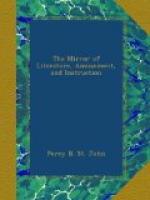XIV.
Haply it stood on that illustrious ground
Where circling columns once,
in sculptur’d pride,
With fine volute or wreath’d acanthus
crown’d,
Rear’d some light roof
by Anio’s plunging tide;
There, in the brightness of the votive
fane
To rural or to vintage gods
addrest,
Those vine clad symbols of Pan’s
peaceful reign
Amidst dark pines their sacred
seats possess’d.
XV.
Or, did it break with soft and silvery
shower
The silence of some marble
solitude,
Where Adrian, at the fire fly’s
glittering hour,
Of rumour’d worlds to
come the doubts review’d?
Go mark his tomb!—in that sepulchral
mole
Scowls the fell bandit:—from
its towering height
Old Tiber’s flood reflects the girandole,
Midst bells, and shouts, and
rockets’ arrowy flight!
XVI.
Warwick, farewell! Long may thy fortunes
stand,
And sires of sires hold rule
within thy walls,
Thy streaming banners to the breeze expand,
And the heart’s griefs
pass lightly o’er thy halls!
May happier bards, on Avon’s sedgy
shore,
Sustain on nobler lyre thy
poet’s vow,
And all thy future lords (what can they
more?)
Wear the green laurels of
thy fame, as now!
[6] These lines will form
a beautiful pendant to the picturesque
Engraving
of WARWICK CASTLE, in No. 357 of the MIRROR—as
well as
to
the very interesting antiquarian description by our
esteemed
correspondent
L.L.
NOTES.
One of the towers of Warwick Castle is complimented with the name of Guy’s Tower; certain ponderous armour and utensils preserved in the lodge are also attributed to Guy; nobody, in short, thinks of Guy without Warwick, or of Warwick without Guy; “Arms and the Man” ought to have been emblazoned on the castle banner; and why should I hesitate to say, that one of the most amiable of children perpetuates the heroic name within its walls? Had this renowned adventurer been ambitious of patriarchal honours, his descendants might have extended the ancestral renown, and have furnished many a ballad of those good old times; but when the Saxon Ulysses had returned from his pilgrimage to Jerusalem, and made an end of Colbrand and the Dun Cow, his fancy was to take alms in disguise from his own fair lady, at his own castle gate, and then retire (tous les gouts sont respectables) to a certain hole or cave called Guy’s Cliff, where he amused himself (in the intervals of rheumatism) for the rest of his natural life in counting his beads and ruminating on his sins, which, as he was a great traveller and a hero, might have been considerable.
STANZA III.
The following interesting passage is copied from a book of ordinary occurrence, in which it is cited without stating the authority. It is more than doubtful if any other nobleman in the kingdom, at that time or since, has projected or executed so much on his own property as the late Earl of Warwick:—




